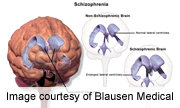
FRIDAY, April 5 (HealthDay News) — Certain brain circuits function abnormally in children at risk of developing schizophrenia, according to a new study.
These differences in brain activity are detectable before the development of schizophrenia symptoms, such as hallucinations, paranoia and attention and memory problems.
The findings suggest that brain scans may help doctors identify and help children at risk for schizophrenia, said the researchers from the University of North Carolina at Chapel Hill.
People with a first-degree family member (such as a parent or sibling) with schizophrenia have an eight- to 12-fold increased risk of developing the mental illness. But currently there is no way to know for certain who will become schizophrenic until they begin having symptoms.
In this study, the researchers performed functional MRI brain scans on 42 children, aged 9 to 18, while they played a game in which they had to identify a simple circle out of a lineup of emotion-triggering images, such as cute or scary animals. Half of the participants had relatives with schizophrenia.
The brain scans showed that the circuitry involved in emotion and higher order decision making was “hyperactivated” in children and teens with a family history of schizophrenia. This suggests that the task was stressing out these brain areas, according to the study, which was published online recently in the journal Psychiatry Research: Neuroimaging.
“This finding shows that these regions are not activating normally,” senior study author Aysenil Belger, an associate professor of psychiatry at the UNC School of Medicine, said in a university news release.
“We think that this hyperactivation eventually damages these specific areas in the brain to the point that they become hypoactivated in patients, meaning that when the brain is asked to go into high gear it no longer can,” Belger said.
Being able to identify at-risk people before they actually develop schizophrenia may help prevent them from developing it at all.
“It may be as simple as understanding that people are different in how they cope with stress,” Belger said. “Teaching strategies to handle stress could make these individuals less vulnerable to not just schizophrenia but also other neuropsychiatric disorders.”
Schizophrenia symptoms usually begin in the late teens or 20s, with men often showing symptoms earlier than women, according to the U.S. National Institute of Mental Health. The disorder is rare in children and people over age 45.
More information
The U.S. National Institute of Mental Health has more about schizophrenia.

